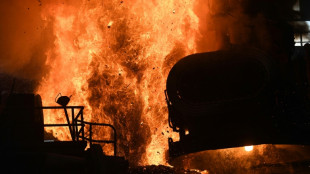
-
 Asian markets mixed as tariff uncertainty looms large
Asian markets mixed as tariff uncertainty looms large
-
South Korea's Yoon blames 'malicious' opposition for martial law bid

-
 Russia's 'shadow fleet' brings 'high risk' of oil spill
Russia's 'shadow fleet' brings 'high risk' of oil spill
-
Doncic off the mark as Lakers rout Jazz

-
 Trump signs executive orders for steel, aluminum tariffs to start March 12
Trump signs executive orders for steel, aluminum tariffs to start March 12
-
Trump floats Ukraine 'may be Russian someday' ahead of Zelensky-Vance meeting

-
 Pacific nation Vanuatu elects prime minister
Pacific nation Vanuatu elects prime minister
-
'My own Apocalypse Now': 'White Lotus' returns with steamy Thailand romp

-
 Malaysia's Hindus mark Thaipusam festival with fervour
Malaysia's Hindus mark Thaipusam festival with fervour
-
Philippine divorce activists vow to fight on

-
 Virus disinformation drives anti-China sentiment, lockdown fears
Virus disinformation drives anti-China sentiment, lockdown fears
-
World leaders seek elusive AI common ground at Paris summit

-
 Asian markets swing as tariff uncertainty looms large
Asian markets swing as tariff uncertainty looms large
-
Venezuela sends planes to fetch irregular migrants from US

-
 Google changes name of Gulf of Mexico to 'Gulf of America' for US users
Google changes name of Gulf of Mexico to 'Gulf of America' for US users
-
YouTube, the online video powerhouse, turns 20

-
 Playgrounds come alive again with Brazil school phone ban
Playgrounds come alive again with Brazil school phone ban
-
'So fast': NY subway shove survivor captures commuter fears

-
 Could a climate megaproject cloud Chile's unparalleled views of universe?
Could a climate megaproject cloud Chile's unparalleled views of universe?
-
Trump's tariff tactics may reshape global trade: analysts

-
 Trump warns 'all hell' will break loose if Gaza hostages not returned
Trump warns 'all hell' will break loose if Gaza hostages not returned
-
Trump warns of 'all hell' if Gaza captives not freed by Saturday

-
 Trump signs executive orders on steel, aluminum tariffs
Trump signs executive orders on steel, aluminum tariffs
-
Elon Musk heads group trying to buy control of OpenAI: report

-
 Young, Irving replace Giannis, Davis in NBA All-Star line-ups
Young, Irving replace Giannis, Davis in NBA All-Star line-ups
-
US judges challenge Trump cuts as legal battles mount

-
 Celtic's Maeda cleared to face Bayern Munich
Celtic's Maeda cleared to face Bayern Munich
-
Global stock markets brush off latest Trump tariffs

-
 Union sues over US consumer protection agency work pause
Union sues over US consumer protection agency work pause
-
Inter a point behind leaders Napoli after squeezing past Fiorentina

-
 Palace sink Doncaster to book clash with rivals Millwall
Palace sink Doncaster to book clash with rivals Millwall
-
Ntamack banned for Italy game despite France efforts

-
 Duterte's future in balance as Philippine election season kicks off
Duterte's future in balance as Philippine election season kicks off
-
At least 55 dead after Guatemala bus plunges into ravine

-
 Ronaldo reaches deal with Saudi club Al Nassr to extend contract: source
Ronaldo reaches deal with Saudi club Al Nassr to extend contract: source
-
Man City still worst opponent for Real Madrid, says Ancelotti

-
 Trump team orders work pause at US consumer protection agency
Trump team orders work pause at US consumer protection agency
-
'Just not ready' - Tiger Woods pulls out of Torrey Pines tournament

-
 Zelensky to meet JD Vance in Munich on Friday: Kyiv presidency
Zelensky to meet JD Vance in Munich on Friday: Kyiv presidency
-
Church of England meets amid 'crisis' over abuse scandals

-
 Macron vows at summit France to 'deliver' on AI acceleration
Macron vows at summit France to 'deliver' on AI acceleration
-
NY jury hears attacker 'dangerously close' to killing Salman Rushdie

-
 Steel at heart of new Trump trade war
Steel at heart of new Trump trade war
-
Hamas says stops Gaza hostage release 'until further notice'

-
 Cycling: five rough diamonds who dream of being the new Pogacar
Cycling: five rough diamonds who dream of being the new Pogacar
-
'I don't have time': Mother of jailed UK-Egyptian makes Starmer plea

-
 Feyenoord coach Priske pays for 'lack of chemistry'
Feyenoord coach Priske pays for 'lack of chemistry'
-
White S. Africans clamour for US resettlement after Trump order

-
 Kanye West's account on X goes dark after hate-filled rant
Kanye West's account on X goes dark after hate-filled rant
-
US federal workers weigh Trump buyout as court to step in


'So fast': NY subway shove survivor captures commuter fears
Joseph Lynskey was quietly waiting for the New York subway on New Year's Eve when someone shoved him from behind onto the tracks as a train pulled into the station.
Highly publicized horror stories like Lynskey's have had a chilling effect on many New Yorkers even as authorities say crime is down on the metro system and across the city.
Lynskey survived because he fell into a deeper, recessed space under the train and between the tracks, and was not hit by the wheels but rather the undercarriage.
"I knew instantly... that somebody had pushed me and tried to kill me," the music producer told AFP of the attack at the 18th Street subway station in the Chelsea neighborhood of Manhattan.
"When I hit the tracks and I opened my eyes, the train was on top of me. It was so fast."
He recalled thinking "I'm going to get hit by the train and I'm going to die."
A 45-year-old adopted New Yorker, he has not been able to return to the subway, used by four million people daily who flock to the sprawling network of 472 stations and more than 660 miles of track, running day and night.
When he looked around after falling onto the tracks, Lynskey recalled being just inches from the high-voltage rail that powers trains, and seeing his blood pooling on the rail bed.
He was left with a fractured skull, four broken ribs and a ruptured spleen.
"I knew that I had to remain calm. There was nobody on the platform answering my calls for help. For about 90 seconds, I was alone, screaming for help," he said.
"A woman started answering me... a Good Samaritan. She asked me what my name was. She asked me if I could move. She asked me if I could wiggle my fingers and wiggle my toes to see if, I guess if I was paralyzed, and I think she was trying to keep me awake."
Within minutes firefighters, police and subway workers arrived, with two firefighters retrieving him from the tracks, having been trained to do so just days before.
Lynskey later met his rescuers to give them a hug and thank them properly.
His rescue was captured on film and widely shared on social media, with rescuers expressing surprise that he was alive once he was lifted through the gap between two carriages.
Lynskey still struggles to understand why his attacker, a 23-year-old man with criminal convictions and mental health issues, would want to harm him.
He chooses instead to focus his attention on the kindness of strangers, like those who have written to him from around the world to express solidarity.
- 'Back against the wall' -
Last year 26 people were pushed or fell onto tracks, one of whom died, an increase of nine on 2023, police say.
Cases like Lynskey's, though rare, attract a disproportionate share of headlines and public awareness.
Another subway tragedy that shocked New Yorkers became front page news in May 2023 when Jordan Neely, an unhoused Michael Jackson impersonator who had struggled with psychiatric issues, was choked to death by a former US Marine, Daniel Penny.
Penny was charged with murder despite claiming he acted in self-defense when Neely became agitated, and a jury acquitted him.
Similarly shocking was the killing of a woman who was set alight by another passenger.
One rider, Marissa Keary, 24, said that she had "definitely heightened" her vigilance when riding the metro.
"If I have to wait, I'll have my back against the wall, and I'll also stand near another woman," she said.
Lynskey said that the subway operator could do more to make passengers feel safe.
"I think everyone deserves to feel safe when they go down into their commute," he said.
Despite chronic issues with reliability and dirtiness, the subway remains the fastest way for the city's eight million people to crisscross the tightly packed urban jungle.
In mid-January, authorities stepped up police patrols at stations and on trains, while also steeping up mental health outreach and erecting barriers on the edges of some platforms.
Administrators said they hope that President Donald Trump does not scrap a $9 per car congestion charging scheme despite his opposition to the measure which will be used to fund a $65 billion subway overhaul bill, and the system's $48 billion debt pile.
N.Fournier--BTB
